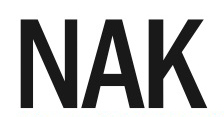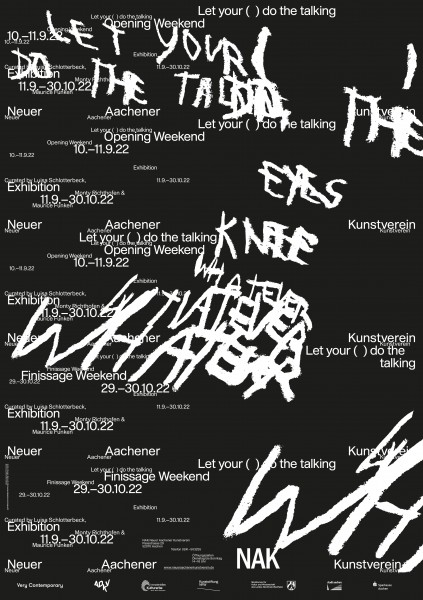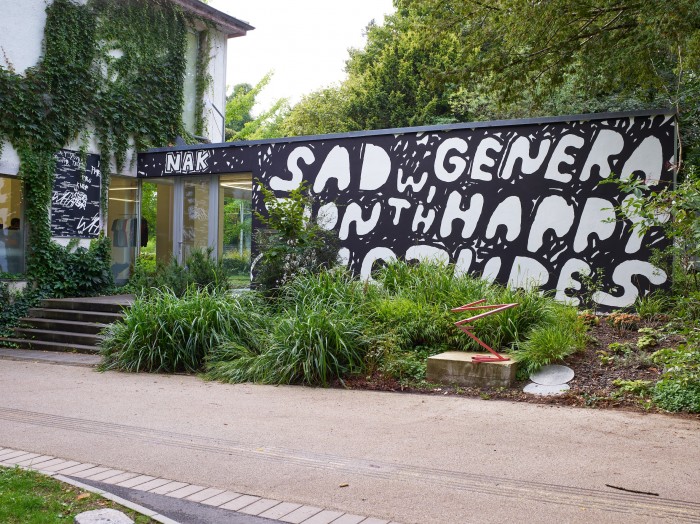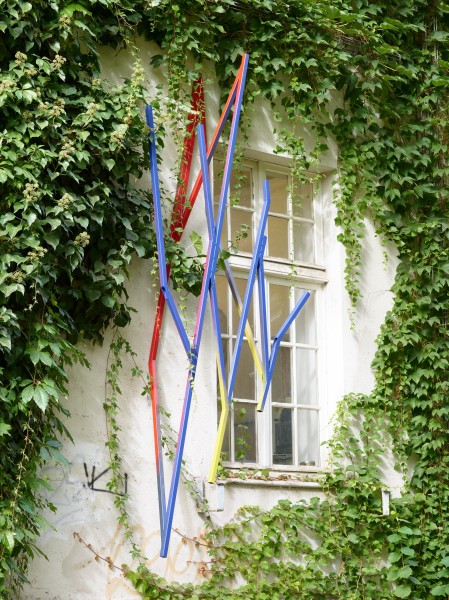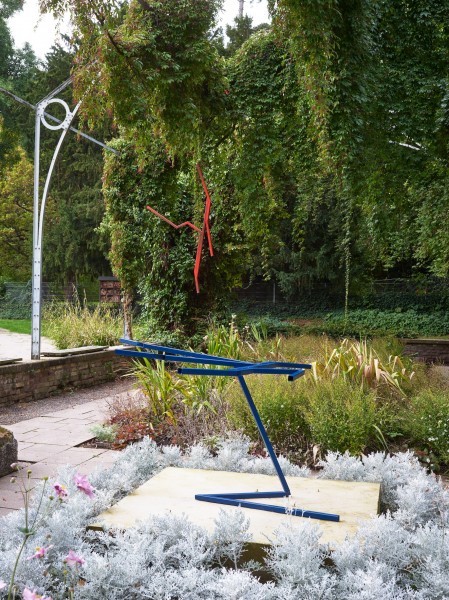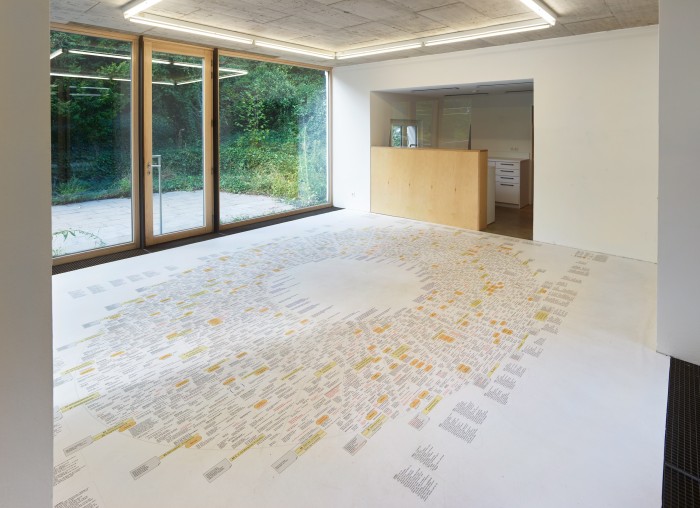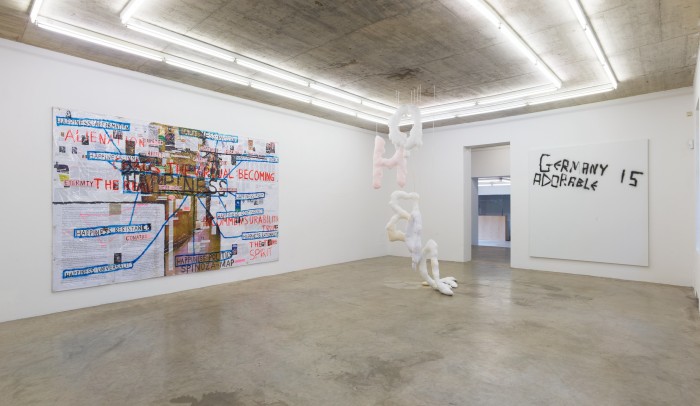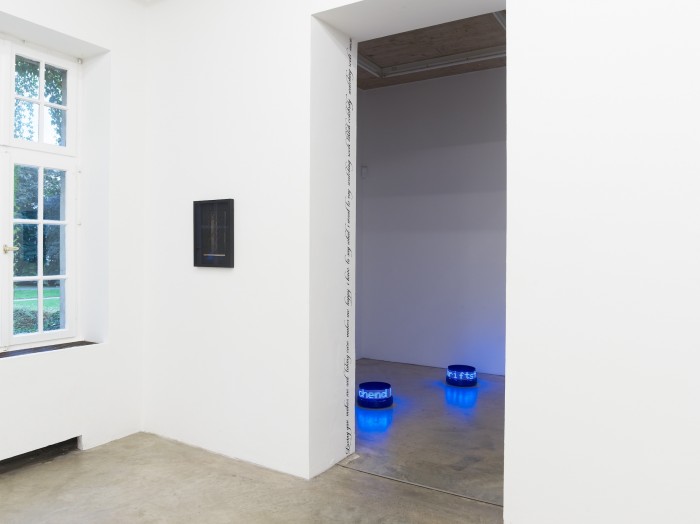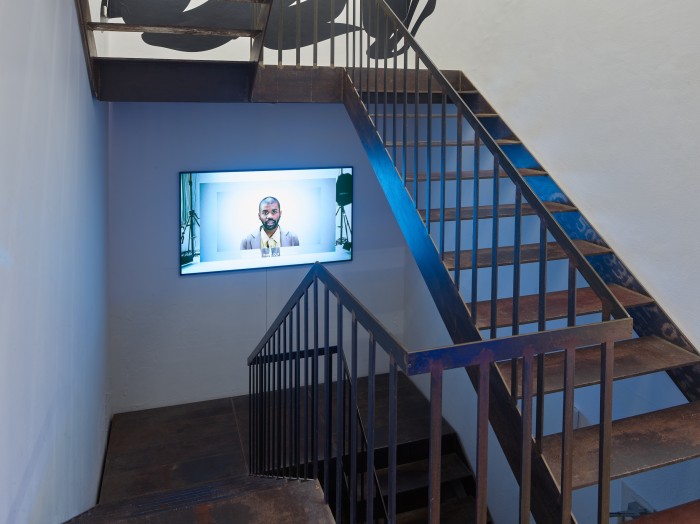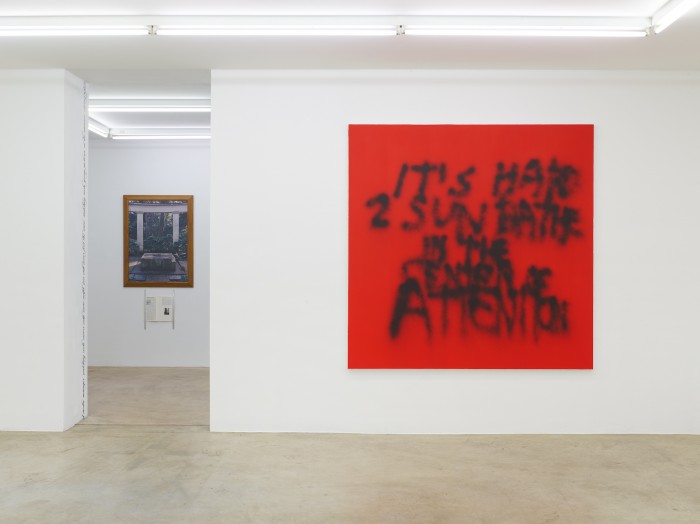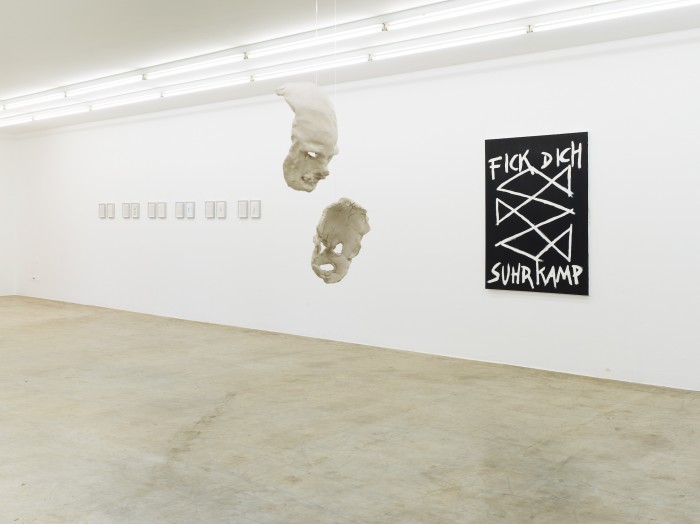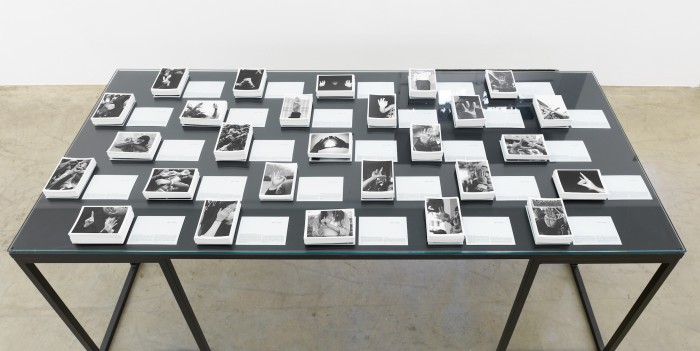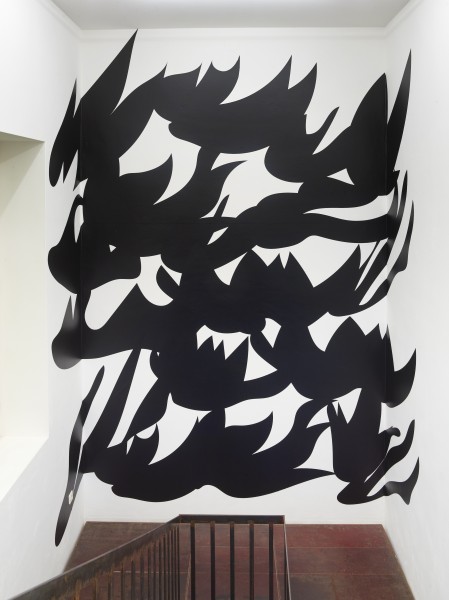Let your ( ) do the talking
Var.
OPENING:
Saturday 10 September 2022
5 — 11 PM
OPEN:
11 September
—
30 October 2022
LET YOUR ( ) DO THE TALKING
eyes, knee, whatever
Curated by Luisa Schlotterbeck, Monty Richthofen & Maurice Funken
Duration: September 11 – October 30, 2022
Opening Weekend: Saturday & Sunday, September 10 – 11, 2022
Finissage Weekend: Saturday & Sunday, October 29 – 30, 2022
The exhibition Let your ( ) do the talking, eyes knee whatever opens September 10 and 11 at NAK Neuer Aachener Kunstverein.
The conceptual framework of the extensive group exhibition focuses on the experience of immediate, linguistic proximity; the exhibition seeks to reflect linguistic proximity-distance relationships as well as their poetic, political, or concrete effects. It is about the immersive experience of language; it is about the emotional experience of its meaningfulness or its nonsense and about the attempt to understand linguisticity as a sensitive and multifaceted organ with which we communicate and inscribe ourselves. This exhibition is not about dematerialization, but about an even more central component of the concept of the work.
We are accustomed to viewing works of art as manifestations of very specific, individual choices. We don’t want to define the recipients. They can do that themselves, if they wish. Quite in the spirit of Lawrence Weiners: the use of writing not to prescribe.[1] Often the beauty of language lies in its fragility, in its contradiction to a fixed norm, or in its refusal to conform of custom and propriety, or to the expectations that go with it (e.g. the expectation of its mistress, grammar); and this without necessarily being indecent. The linguistic intelligence of a dyslexic shows more of that brittleness than the linguistic onanism of rhetorical figures that putty and polish that very same brittleness. If we understand grammar, for example, as a set of rules of language, like a code that can be perfectly encoded and decoded, then one understands, but one no longer needs to communicate. Once you have perfectly decoded the language, you have reached the end. A misunderstanding keeps us awake, blanks make us search. Failure demands greater sensitivity and keeps us open to different readings[2] and expressions. Misunderstanding makes us pause and deepen in the in-between of our routinely dualistic truths. Perhaps the fallibility of language leads to new dialects. Perhaps an essence of linguistic communication lies in its incomprehensibility: perhaps it is good if it does not always go down like butter.
“The poet is always our contemporary.” [3]
Inviting artists from almost all age groups, as well as autodidacts and professional artists and writers, promotes both an intergenerational exchange, an alignment of languages, and a questioning of one’s own rhetoric. The exhibition will oscillate between different languages and the question of a universal understanding of language, seeking how language and voice occupy and balance different spaces in contemporary art; thus questioning different aspects of the understanding of linguisticity and beauty or ugliness. In addition to the works gathered in the group exhibition, performers and authors are invited to share their chosen contributions and communicate through visual, auditory, or performative interventions. Readings and book presentations or discussion-seeking encounters are also planned. Out of the rooms, in situ works and commentaries stretch along the building, through the Kurpark and out into the city. The exhibition argues inter- or transdisciplinary and is broad in the represented genres, formats and media.
The exhibition is organized and curated by Luisa Schlotterbeck (Artistic Director, Neue Galerie Gladbeck), Monty Richthofen (Artist) and Maurice Funken (Director, NAK Neuer Aachener Kunstverein). Exhibition text by Luisa Schlotterbeck.
With the kind support of:
Accompanying program Vernissage and Finissage
Saturday, 10.09.2022
5 pm – Opening
7 pm – Inga Krüger: Performance
7.30 pm – Dr. Werner Dohmen: Speech of the chairman of the board
7.40 pm – Luisa Schlotterbeck, Monty Richthofen, Maurice Funken: Speech of the curators
8.30 pm – Richie Culver: Performance
Sunday, 11.09.2022
3 pm – Mafia Tabak: Cooking Performance
Saturday, 29.10.2022
5 pm – Ndayé Koagou: Performance
7 pm – Arts of the Working Class: Talk and Reading with María Inés Plaza Lazo & Jeronimo Voss
All day – Monty Richthofen: Wall drawing for the NAC
Sunday, 30.10.2022
2 pm – Boris Nieslony: Performance
5 pm – Thomas Musehold: Book presentation and reading
7 pm – Inga Krüger: Performance
Participating artists
HAVIN AL-SINDY (*1987, Zaxo, Iraq) first studied biology and chemistry at the University of Duisburg – Essen and completed her art studies as a master student at the State Academy of Fine Arts Stuttgart in 2019. Subsequently, she was a guest student in the class of Professor Gregor Schneider at the Düsseldorf Academy of Art. Her works are in the field of conceptual art and painting. In her work she deals with the questions of memory and its reconstruction, with localization and de-localization from different artistic and scientific perspectives. Al-Sindy lives and works in Stuttgart and Düsseldorf.
ARTS OF THE WORKING CLASS | MARIA INÉS PLAZA LAZO & JERONIMO VOSS Arts Of The Working Class is a multilingual street newspaper about poverty, wealth and art. The newspaper is published every two months and contains contributions from artists and thinkers from different fields and countries. The issues are an expression of a counter-movement to the exclusion mechanisms of overpriced glossy magazines “on the coffee tables of the privileged”. Produced by people of the “art precariat” together with the advertised artists, The Arts of the Working Class is given away to homeless people, students, interns and low-income earners for resale. It is aimed at the working_class, that is, everyone, and it is about all that belongs to everyone. The concept of Arts of the Working Class was developed by Paul Sochacki, María Inés Plaza Lazo and edited with Alina Kolar. The newspaper is published for the streets of the world.
SOPHIE CALLE (b. 1953, Paris, France) is a French artist who has had numerous exhibitions around the world since the late 1970s. She has been described as a conceptual artist, photographer, film director, and even a detective, and has developed a practice that is immediately recognizable for its distinct narrative elements and frequent combination of images and text. Each of her projects can be seen as a chapter in a vast overall volume of references and echoes, in which Calle often blurs the lines between the intimate and the public, reality and fiction, art and life. Calle lives and works in Malakoff, near Paris, and in New York.
KYRILL CONSTANTINIDES TANK (*1990, Munich, Germany) studied art in Munich and was the 2018 prize winner for poetry at the 26th open mike in Berlin. In mid-2019, his first book Janus Neinus Vielleichtus was published by Wirklichkeit Books: while working in the museum store, the artist and poet draws on postcard-sized scratch sheets. They depict scenes of everyday work in the museum or ideas that can only be thought of there, and tell of the artist’s life between paid work and artistic creation. Constantinides Tank lives and works in Munich.
RICHIE CULVER (*1979, Hull, England) is self-taught; he left school without a degree to work initially in a caravan factory. Now his artistic practice encompasses various elements ranging from painting, sculpture and photography to digital performance. A large part of Culver’s working method, lies in his antagonistic relationship with technology, the impermanence of social media, and the impact on human interaction and linguistics, as well as personal and cultural memory. His work has been shown in numerous international solo and group exhibitions. Culver lives and works in London, England and Porto, Portugal.
MARCEL HILLER (*1982, Potsdam) studied Fine and Visual Arts at the Kunstakademie Münster, the Haute École d’Art et de Design in Geneva, and postgraduate studies at the Jan Van Eyck Academie in Maastricht and the Künstlerhaus Büchsenhausen in Innsbruck. His biography corresponds to the sociological attribution of the “Wendekinder”. His origins, which he himself perceived as a flaw, were expressed through the consistent avoidance of any biographical references. Many of his installations were determined by meaning-laden materials and found objects without ever becoming explicitly legible as objects or signs. Their atmospheres generated as interiors of an ego-less, giving shape to the spaces of his exhibitions and their specific zero point. Now he writes: “In the meantime, the institutions of my public have become rather the spatial and temporal background of a reconstruction of my own, as useful as, say, the rubber lip of a windshield wiper.” He has received various prizes and been awarded grants for his artistic work. Marcel Hiller lives and works in Cologne.
THOMAS HIRSCHHORN (*1957, Bern, Switzerland) completed an apprenticeship as a typographer and then studied at the Hochschule für Gestaltung und Kunst in Zurich. The artist chooses everyday construction and packaging materials such as plywood, cardboard, adhesive tape, plastic and aluminum foil for his installation works. These are supplemented by images and texts from newspapers and magazines as well as philosophical texts by writers and philosophers he admires. Hirschhorn’s conception of art as political-social engagement wants to make connections visible and confront the viewer with them. Hirschhorn lives and works in Paris.
ARTOR JESUS INKERÖ (*1989, Helsinki, Finland) studied at the Academy of Fine Arts, Helsinki and the Rijksakademie, Amsterdam. Inkerö’s multidisciplinary practice includes video, performance, photography, painting as well as sculpture; in it, Inkerö works on Western stereotypical notions of masculinity in a kind of long-term performance. For the exhibition, the artist has developed an intervention in public space, which will be billboarded in Aachen. Inkerö works in Helsinki and Amsterdam.
BARBARA KAPUSTA (b. 1983, Lilienfeld, Austria) studied at the Academy of Fine Arts, Vienna and attended the Centro Nacional de las Artes in Mexico City. In her artistic practice, the connection of the body with materiality and language is a central, recurring element. She engages with time-based digital media, sculpture, queer feminist theory, and poetry. In her work, fictional bodies articulate partial perspectives and queer agency to challenge imperial gestures of universality and binary structuring. She teaches at the Academy of Fine Arts Vienna, received the Otto Maurer Prize in 2020, and has exhibited at Kunsthalle Bratislava (2022), Kunsthaus Hamburg, mumok, Vienna, and ACF London, among others. Kapusta lives and works in Vienna.
NDAYÉ KOUAGOU (*1992, Paris, France) is an artist and performer whose artistic practice always starts from his texts. In his performances as well as video works, he deals in particular with reflections on legitimacy, freedom or love. Kouagou’s works have been shown at the Centre Pompidou, Paris, the Wiels, Brussels or the Centrale Fies in Italy and Lafayette Anticipation, Paris, among others, where he also launched his publishing project YBR* (Young Black Romantics). He lives and works in Paris.
INGA KRÜGER (b. 1988, Iserlohn, Germany) studied at the Kunstakademie Münster in Suchan Kinoshita’s class and the Royal Institute of Art Stockholm. Her artistic work is difficult to locate in technical or aesthetic categories, but always reacts directly to the exhibition site or the respective, found situation and the specific conditions. Almost playfully, she immerses herself in the history, architecture, or social structures of various locations and develops a coherent Gesamtkunstwerk using a variety of means. Her work has recently been on view at the Institut de Carton, Brussels, or Malkastenpark, Düsseldorf. She lives and works in Düsseldorf.
MAFIA TABAK (*1990, Austria) has been working with graffiti since 2016, developing a very unique visual language that is also applied in the studio. Thus, his visual vocabulary runs through paintings, installations, drawings or prints. His paintings and murals always refer to phenomena from pop culture, such as television series, cartoons, anime and video games. For the NAK, the artist will design a wall but also realize a performative dinner for the exhibition opening. Mafia Tabak lives and works in Vienna.
STEFAN MARX (*1979, Schwalmstadt) has been working with typefaces for about twenty years. They are song lines, sayings, sentences, quotes, which he implements with his own scripture and its distinctive style, in paintings or drawings as well as on surfaces. His mostly monochromatic drawings are chronicles of daily life. They are direct and personal, often comical and good-humored. Marx observes his surroundings and creates scenarios that offer sympathetic insights into the zeitgeist and modern society. Most recently, Marx exhibited at the Hamburger Kunsthalle, among other venues. Marx lives and works in Berlin.
JAMES MÆSSIAH (b. 1990, London, England) is a poet and musician from South London whose work explores themes of sexuality, mortality, and philosophy through performative work, writing, and via visual media. In his ongoing series New Poems, he describes experiences from his life in London and formulates ideas about love and work. Mæssiah has worked for the BBC, the Guardian, and Nike, among others, and has appeared in campaigns for Selfridges, Loewe, Adidas, and Champion. He has read at the Tate Modern, the Courtauld, the Institute of Contemporary Arts and the Houses of Parliament. He has also curated events for Boiler Room and hosts the monthly ‘Poætry Show’ on NTS Radio. Mæssiah lives and works in London.
MARIANNE MISPELAËRE (b. 1988, Bourgoin-Jallieu, France) graduated from ESAL in Épinal and HEAR in Strasbourg in 2009. Her artistic practice is particularly dedicated to language and alternative forms of communication: where narratives exist but words seem inappropriate. She works in a mutlidisciplinary way, developing projects and concepts that connect her to places and their people. She has shown her work in exhibitions at Palais de Tokyo, Paris, FRAC Normandie-Rouen, FRAC Alsace, iselp Brussels, and Art Encounters Foundation, Timisoara, among others. In 2017, she was awarded the Grand Prix du Salon de Montrouge. Her work has been nominated for the LEAP Prize and for the AWARE Prize – Archives of Women Artists, Research and Exhibitions by Hélène Guenin. Mispelaëre lives and works in Aubervilliers close to Paris, France.
THOMAS MUSEHOLD (*1982, Mönchengladbach, Germany) studied linguistics at the Westfälische Wilhelms-Universität Münster and visual arts at the Kunstakademie Münster under Prof. Suchan Kinoshita and postgraduated at the Jan Van Eyck Akademie in Maastricht. Musehold continues to deal with the theme of interpretation and interpretation of the unknown, making different use of the system of language. In doing so, he succeeds in creating a fantastic knowledge that opens up a space of experience for the mystical and the imagination. Musehold’s language seems to figuratively reproduce the etymological origin of the word “comprehend.” By scanning the surface piece by piece through the word, one feels one is approaching the object spiritually. Like Caillois, Musehold engages in a game of objectification based on the idea of eliciting specific meaning from things, however alien they may seem. His work has been shown in various solo and group exhibitions, including at the Kunsthaus NRW, the Ludwig Forum, and the Philara Collection. In 2020, he took up the Bronner Residency in Tel Aviv. At the NAK, the artist will present his recently released publication LARVA with a reading and roundtable discussion. Musehold lives and works in Düsseldorf.
BORIS NIESLONY (*1945, Grimma) is active worldwide as a performance and installation artist with his performances and exhibitions, with lectures and as a mediator. In the 1970s he studied at the art academies in Berlin and in Hamburg. Since 1981 he developed a comprehensive archive on performance art, artists-run-spaces and their theoretical-philosophical foundations. He participated in documenta 8 in 1987. In 1985, together with European performance artists, Nieslony initiated the model “Black Market International”, in 1990 the performance network Arts Service Association (ASA), and in 1995 the first performance conference in Cologne, which has been followed by eighteen other events worldwide to date. In 2001 he founded the E.P.I. Center, the European Performance Institute, and in 2010 initiated PAErsche, another performance network between artists, organizations and projects. In 2019, the Kunstmuseum Ratingen dedicated a first comprehensive, diagrammatic exhibition of his thought images in visual design to him. Together with the diagrammatist Gerhard Dirmoser, Nieslony worked out a performance diagram over a period of ten years, the original measuring eight by eight meters. The circular diagram of countless terms, arranged in 32 segments around an empty center, poses the question: What is performance? Boris Nieslony lives in Cologne.
PMS is a Belgian fashion label that wants to draw attention to premenstrual syndrome with its shirts. The colorful shirts with eye-catching PMS branding will be shown and sold at the Kunstverein.
DANIELE PUSINANTI‘s (b. 1985, Bologna, Italy) interest in graffiti drove him to travel around Europe painting urban trains. During one of his trips to Stockholm, he was hit by a train while painting a subway in the underground caverns. The accident ended with a near-death experience that confined him to bed for five months. A few months after his recovery, Pusinanti finished his art studies and exhibited his first works in Bologna, where he founded the art collective Rialto18. His artistic practice explores, among other things, painting as a communication tool. His often gestural and provocative visual aesthetics tell of contemporary structures of exclusion, representative forms of representation, and mechanisms of value creation. Pusinanti lives and works in Berlin.
JOHANNA REICH (*1977, Minden) studied at the Kunstakademie Münster with Andreas Köpnick, Paul Isenrath and Guillaume Bijl, at the Hochschule für Bildende Künste Hamburg with Gerd Roscher and Wim Wenders, and at the Kunsthochschule für Medien Köln with Mischa Kuball, Jürgen Klauke and Matthias Müller. From 2020 to 2022 Johanna Reich had accepted a substitute professorship at the Academy of Fine Arts Munich. The media artist deals with the question of the relationship between reality, image and likeness and investigates the influence of new media on our perception and our thoughts and actions. In doing so, her work encompasses a broad spectrum of creative media and formats. She combines contemporary techniques such as photography, video, performance or holographic projections with traditional media such as painting or sculpture. A central element of her works is her performative acting in front of the camera and at the same time the disappearance from the medially determined world, the withdrawal of the artist herself. She has been awarded the Japanese Excellence Prize for Media Arts, the Förderpreis des Landes NRW für Medienkunst, the Konrad-von-Soest-Preis and the Nam June Paik Award, among others. She lives and works in Cologne.
MONTY RICHTHOFEN (b. 1995, Munich), also known by his artist name Maison Hefner, studied performance and design at Central Saint Martins University of the Arts in London. Since graduating in 2018, he has been intensely challenging conventional poetry, such as through the painterly visualization of texts, writing in public spaces, and handwritten tattooing. Richthofen lives and works in Berlin.
FRANCA SCHOLZ (*1988, Munich) studied media art at the University of Art and Design Karlsruhe, then at the Kunstakademie Düsseldorf, and since 2017 Media Arts at the Academy of Media Arts Cologne. With her video projections, performances, and installations of textile, anthropomorphic objects, Franca Scholz addresses physical relationships between intimacy, distance, dominance, and exclusion. Scholz’s artistic practice is grounded in both self-penned texts and quotations from autofictional literature with female authorship, articulated as spoken or written words in space. The fragmented narratives of desire, domesticity, and (in)visibility draw attention to the mutual fragility and incompleteness of linguistic and corporeal representation. In 2019, she received the Peter Mertes Fellowship. Scholz lives and works in Cologne.
LUKI VON DER GRACHT (*1992, Aachen) studied at the Düsseldorf Art Academy. The artist pursues a multidisciplinary approach of performance, painting, drawing, video and installation, which thematically revolves around questions of identity, community and power structures. For the current exhibition at the NAK, she continues an uncommented intervention in public urban space with the billboarding of her written and pictorial collages, which was initiated in the previous exhibition Queering the Narrative. She lives and works in Berlin.
NICHOLAS WARBURG (*1992, Frankfurt am Main) studied art at the California Institute of the Arts in Santa Clarita and at the Städelschule in Frankfurt am Main (master student of Tobias Rehberger). His works, which deal with German history and art history in an ambivalent way, have been shown at Kunstpalast Düsseldorf, Kunstraum Potsdam, Kunstverein Leipzig and Kunsthalle Portikus. He has been awarded prizes, fellowships and residencies by Künstlerhilfe Frankfurt, Stiftung Kunstfonds, neue Gesellschaft für bildende Kunst Berlin, Q21 Vienna and the Lichter Art Award. In the winter semester of 2021/22, he was a visiting professor at the Berlin University of the Arts. He is also a co-founder of the groups Frankfurter Hauptschule and Tannhäuser Kreis. He lives and works in Frankfurt am Main.
[1] See. Joachim Büthe, Lawrence Weiner: Gefragt und Gesagt, 02.05.2005, Deutschlandfunk.
[2] For example, Ingeborg Bachmann’s Udine theme could also be understood in a non-feminist reading. Is Udine the art and we the Horst people?
[3] Virginia Woolf, Wie man ein Buch lesen soll?, in: Granit und Regenbogen. Essays., 1960, 9-24.
